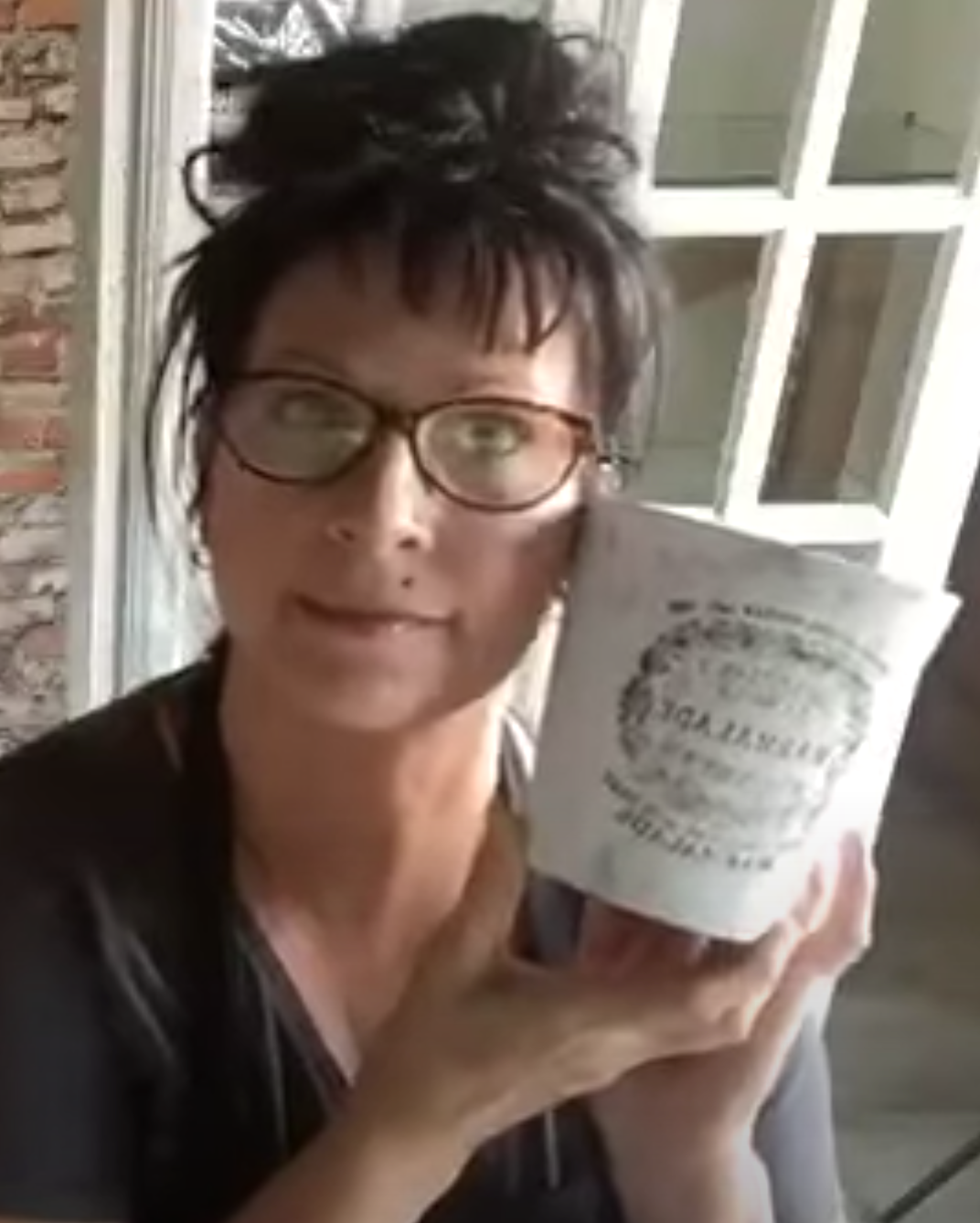How to use IOD Stamps on a Curved Surface
Looking to pretty up thrift store finds, upcycle a pickle jar into a vase, or make a flow blue terracotta pot but you’re worried about how to use IOD stamps on a curved surface? Well, you’re in the right place because that’s ALL we’re talking about in this DIY tips and tricks post.
This post focuses on the stamping process and how to get a beautiful impression — not on the finished product.
That means you get this for the beauty pic… Isn’t Josie too cute as she does her “Price is Right” model pose? 🤣 ❤️ 🤣
Here’s what you will get in this post. Two silly sisters (yes, this was filmed BEFORE Josie changed her hair color!) sharing their best advice for embracing all your curves!
No time now? Pin this post for later.

Note: Before you get started if this is your first time using IOD stamps please check out this beginner stamps tutorial. It will give you all the basics including how to condition your stamps before first use.
EMBRACE ALL THE CURVES WITH THESE TIPS!
Watch the shortened Facebook Live video tutorial below. Or, if you prefer to read, keep scrolling for a supply list and a summary of the tips.
Here’s what we used to show you how to use IOD Stamps on a curved surface
We’re sharing a supply list, but you can use any IOD stamps for this “project.” (We put that in quotes because really we just want you to experiment, play and enjoy the process!)
All IOD products can be purchased from an approved stockist. To find a shop local to you, click here. To find an online store, click here.
- Decor ink and a blank ink pad by IOD
- Crockery Stamp by IOD
- Thin mount with gridlines by IOD (optional)
- Scissors
- Flowerpot (or you could also use an upcycled tin can, painted glass jar, or other curved, thrifted housewares item)
- Chunky towel and lint-free shop cloth to lay under your piece
Three Tips for IOD Stamps on a Curved surface
Here they are in a nutshell but keep reading for all the details…
- Use bolstering to keep your piece from rolling as you stamp
- Mount your stamps on a flexible acrylic
- Give special consideration to conical curves, like a flowerpot
Tip #1: Bolstering your DIY project
Bolstering keeps your piece from rolling around your work surface. To create a bolster, fold a junky, chunky bath towel in half lengthwise. Then, lay it out long and roll the ends towards. Finally, flip over the towel while holding the roll ends and lay it on your work surface to create a cradle for your piece.
If you don’t want to get ink on your bath towel, layer a sheet of paper towel over the “cradle” to protect it.

Tip #2: Choose the right mount for your stamp
We used the IOD Crockery stamps for the tutorial. The easiest thing to do is leave each design on the backing that comes with the stamp as the gives the stamp additional structure making it easier to control.
If using the provided backing as your mount, cut out the stamp first.

Then lay the stamp (still attached to the backing) design side up on your work surface. Bring a loaded ink pad to the stamp and pat it to ink the design – this is important, always bring the pad to the stamp and NOT the stamp to the ink.
Hover over the curved piece to get the orientation just the way you want it, then lower the stamp down steady from the center down.

Holding the stamp with your right hand, press down with gentle, even pressure from the center out and then switch hands; applying gentle pressure with your left hand.

Commit and don’t shift – so you don’t smudge the design.

If you need more precise placement and want a bigger surface area to hold the stamp, use an IOD grid lined thin mount. First, remove the backing on the stamp – and don’t be concerned if this might take a little force. Affix the stamp on the grid lined thin mount, taking care that the thin mount is clean and dry. (If you find your stamp not sticking, clean the backside of the stamp with a baby wipe.)
Use the grids as a visual guide as well as providing more surface area to gently press down on the stamp.

Tip #3: How to stamp conical curves (vs. stamping a cylinder)
When the surface area is smaller at the bottom and flares out at the top – like a cone, it’s considered a conical curve. Think flowerpot versus a mason jar, which is cylindrical.
With a conical curve, it is important that you lower the stamp from the center to get a straight application. Avoid rolling the stamp from one side to the other because it will roll with the curve of the piece and you’ll end up with a lopsided stamp.
SHOULD I SEAL MY PROJECT BEFORE STAMPING?
Yes and no – as in it’s totally up to you! Regardless of whether you’re stamping on a curved or flat surface – just keep in mind that your choice will affect the final look of the impression.
Generally, when stamping on sealed surfaces that have a shiny finish, your stamp will have clear, well-defined lines. However, shiny surfaces may smudge easier during the drying process. Comparatively, dull surfaces, such as unsealed chalk or mineral paint, tend to ‘drink up’ or absorb more of the stamping medium. This will give your impression a more muted look.
Unsealed surfaces are also more forgiving when it comes to the stamping process because the surface is not as slippery.
How can I get a crisper, more detailed stamp impression?
Stamping with ink versus paint will change the look of your stamp. Ink tends to yield a more crisp, defined impression. That impression will also be influenced by whether you sealed before stamping and what kind of medium you’re stamping on. Testing your medium to see how the ink or paint will get absorbed is encouraged!
The more you practice with your stamps, the more likely you will achieve the look you are aiming for. Remember- it’s all about the reps!
If you want to practice stamping on a conical surface try this project where you make this beautiful flow blue pot with the Rose Toile stamp.
And if you LOVE the stamp we used on our flowerpot in this tutorial, check out this post for all our favorite ways you can use the IOD Crockery Stamp.

You can also use this stamp to make beautiful impression in IOD Air Dry Clay.

And if you’re looking for one more way to use the Crockery stamp — it’s just gorgeous on cookies!






